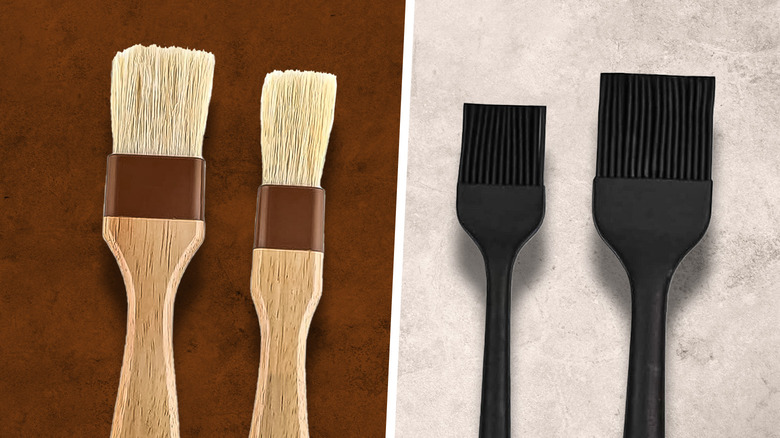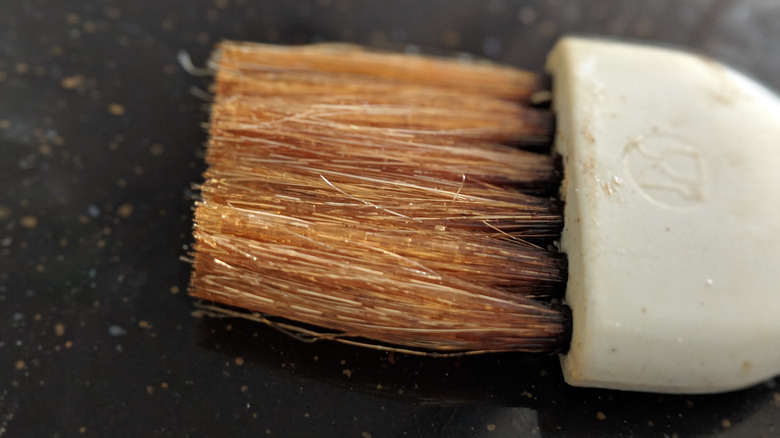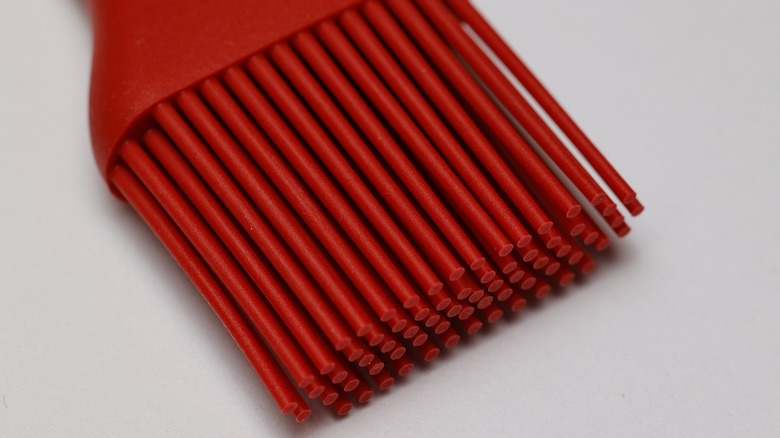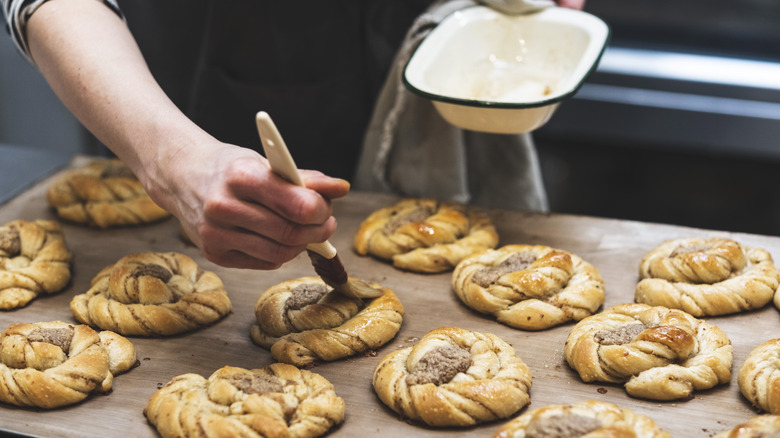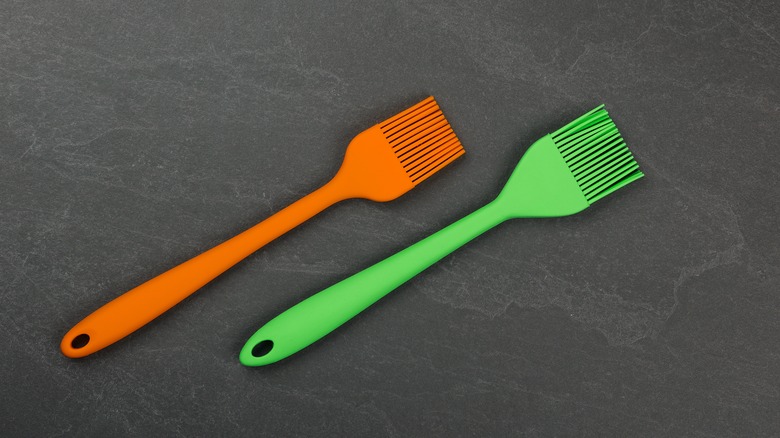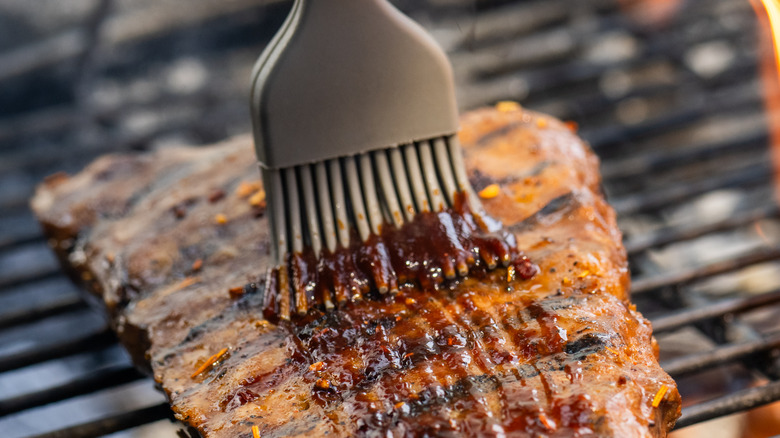Boar Bristles Vs Silicone: What Are The Differences Between These Pastry Brushes?
If you're shopping for pastry brushes, you may notice that you have options. One kind has a wooden handle and tightly packed natural boar bristles like a paintbrush, while the other has a plastic or silicone handle and rows of much larger, flexible silicon bristles, often in bright colors. Each style has its supporters, and some cooks even like to use both, alternating for different applications from egg-washing the most delicate puff pastry to glazing roasted meat or vegetables in a hot oven or on a grill.
Both styles are readily available, comparable in price, and come in a range of sizes and shapes, from flat to round. For most of us, the choice comes down to the way they perform. The main differences are how evenly each type can spread a liquid, how easy they are to clean and sanitize between uses, and how well they stand up to heavy use.
What is a boar bristle pastry brush?
Boar bristle brushes have been around for centuries, and bundles of Russian bristles were being imported by London brushmakers as early as the 1740s. While these were originally used for painting and hair care, bakers soon discovered how well they worked for applying egg washes and other glazes to their dough. Today, most bristles come from China or India, where domesticated boars are raised and sheared like sheep to remove their hair without harming them.
Each pastry brush contains hundreds of these bristles gathered together inside a band. If you run your finger across the hairs, you'll note that they're soft but somewhat firm. Each one is thick and rounded, which helps them hold more liquid every time you dip them into your wash. Instead of coming to a perfect point, their ends may also have flagged tips, which resemble split ends on your hair. This feature expands their surface area to keep the liquid from sliding off of the brush.
What is a silicone pastry brush?
Silicone rubber kitchen tools came into use in the 1960s after scientists discovered that the same heat tolerance and flexibility that worked so well for aircrafts also made sense for kitchen use. This synthetic polymer was soon made into everything from spatulas to baking sheets for the oven, where it could withstand temperatures of up to 480 degrees Fahrenheit without melting. Because the material is so flexible and easy to shape, it can also be formed into strands to make artificial "hairs" for pastry brushes.
This portion of the brush is typically formed in one piece, with all of the strands extending from a single base. Some brushes are made entirely of one piece, with no seams between the handle and application end, which makes them even easier to clean. Unlike natural versions, these strands are thick and uniform from end to end, and there are typically only a few dozen extensions at the end of each brush. The properties and construction of these two brush styles are quite distinct, so it's not surprising that they perform differently too.
Boar bristle brushes hold more liquid
The size and number of bristles is responsible for the variation here. Not only are natural hairs clingier than non-stick, non-porous silicone, but the sheer number of tiny boar bristles on each brush means that the brush can hold much more liquid. This factor alone can be a good guide for which tool to use and when.
For example, if you're applying an egg wash to a pie crust, puff pastry, or baked pretzel, you need to be able to cover the whole surface evenly without damaging the delicate dough. The tiny hairs of a boar bristle brush provide an advantage here. They give you more control as you apply the glaze so that you can avoid globs or bare patches. Plus, because the bristles hold the liquid better than silicone can, you'll have to dip less often. These same characteristics make a natural brush a great tool for get into tiny crevices, like when you're greasing a Bundt pan. On the other hand, for jobs where less precision is needed, like slathering meat or vegetables with butter or sauces, a silicone brush will work just fine.
Silicone brushes are easier to clean
As you might guess, hundreds of densely packed natural bristles are more of a challenge to clean than a few strands of non-stick silicone. Hair bristles need to be washed especially thoroughly after each use to avoid oiliness and clinging odors and flavors that can transfer from dish to dish. Once you've prepared your food, don't let the sauce dry on the brush, or it may be difficult to remove later. If you can't clean it right away, leave it a bowl of water to soak. Then, massage dish soap through the fibers like you're washing your hair, working all the way down to the base and rinsing the bristles thoroughly. One effective method is to wash brushes in the palm of your hand. You can then blot them with towels and leave them out to dry completely before putting them back in the drawer.
On the flip side, silicone brushes are fast and easy to clean. Nothing clings to them, including food, and you can see all the way down to their base to make sure they're clean. If they have plastic or silicone handles, you can even run them through the sanitizing cycle in your dishwasher since they're heat-resistant (natural bristles and wooden handles tend to break down quickly in the dishwasher). Whichever type you choose, you should keep separate brushes for meat and other ingredients to avoid cross-contamination. Some cooks even designate different colors of tools for meat and other ingredients.
Silicone brushes are more durable
The last main difference between these types of brushes is their durability. Over time, the individual bristles in natural brushes can work loose. This can be an annoyance if you're picking loose hairs off the top of your pastry dough. Bald patches also make your brush less effective since they can't spread liquids as evenly. Like any hair, natural bristles can be damaged by heat, so if you're ever reaching into a hot oven to spread a glaze, you can singe your brush. Meanwhile, silicone won't be scathed by high heat, making it a better choice for basting food that you're cooking in the oven or on the grill.
If you're still struggling with which brush to choose, they're inexpensive enough that you can try them both. Perhaps you'll keep the natural fibers for baking and use the silicone variety on the grill, or use one with sweet glazes and the other for savory preparations. As with any technique, experimenting will reveal what works best for you.
